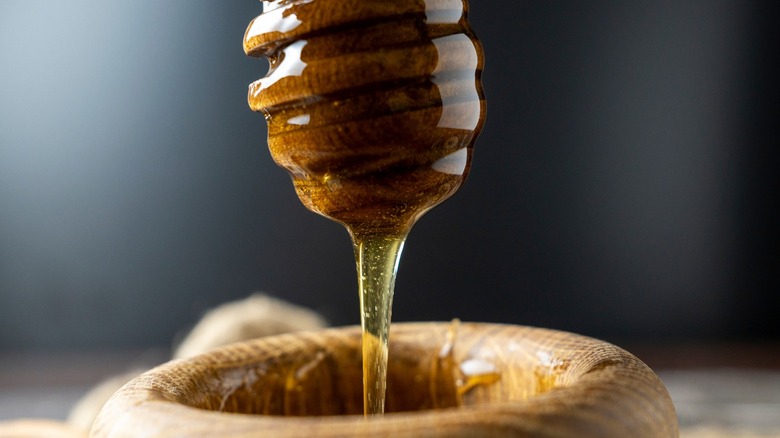Why Honey Should Be Your Go-To Ingredient For Caramelized Dishes
Nearly anything with sugar can be caramelized, so it may come up often in your baking and cooking. But because of taste, nutrition, or some other personal reason, you may not be keen on adding lots of white sugar to your crème brûlée, cheesecake, or caramelized onions. In each of those cases — and plenty more — honey makes for a great substitute for plain sugar and it can even speed up the caramelizing process.
While honey is made by bees using flower nectar, the sticky substance itself is almost entirely sugar and water. So it's perfectly capable of caramelizing on its own. However, honey is made mostly from fructose, which caramelizes at 230 degrees Fahrenheit; store-bought sugar is sucrose, which needs to reach 320 degrees Fahrenheit before it caramelizes. This means your dish can cook faster and, on top of that, you're adding a honey taste that you don't get from standard sugar.
Honey versus sugar
For a quick recap on caramelization, it's basically just the process of melting down sugar until it transforms into a thicker, darker-colored substance with a sweet taste that's sometimes described as buttery. It's how gooey caramel sauce is made, and it's also how you caramelize more complicated dishes like Basque cheesecake. By using honey instead of plain sugar, you're also throwing a more floral taste into the mixture.
Keep in mind that you don't need to use as much honey as you would with normal sugar. Because honey is extra sweet, a good rule of thumb is that when a recipe calls for a certain amount of sugar, you should add half to two-thirds that amount of honey. This way, you can add that specific sweet flavor from honey without throwing all the other ingredients in the dish out of balance. For a more mild honey flavor, go with a mix of honey and sugar and adjust the amounts of each to suit your taste.
Know your honey
Of course, there are several different kinds of honey out there, and each one brings a different taste to your dish. Acacia honey is a lighter honey made with nectar from black locust trees, and it has a lighter color and a much more delicate floral taste. This makes caramelized acacia honey a good fit for more savory meals that include fish like shrimp or salmon. It also goes well with sweeter fruits like peaches. On the other hand, you have buckwheat honey, which is much darker in color and less sweet, having a nutty, malty flavor instead. Its taste is sometimes compared to molasses, so you could compare it to toffee, which is just caramelized sugar with molasses. It goes well with recipes involving alcohol.
There are plenty of other honeys with different profiles. Sage honey is fruitier and lightly spiced, while tupelo honey is very buttery. Choosing the right honey and caramelizing it in place of sugar can be a fast way to add a different sweet flavor to a dish, whether it's your main or a dessert.


